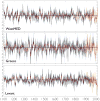Spatiotemporal drought variability in the Mediterranean over the last 900 years
- PMID: 29780676
- PMCID: PMC5956227
- DOI: 10.1002/2015JD023929
Spatiotemporal drought variability in the Mediterranean over the last 900 years
Abstract
Recent Mediterranean droughts have highlighted concerns that climate change may be contributing to observed drying trends, but natural climate variability in the region is still poorly understood. We analyze 900 years (1100-2012) of Mediterranean drought variability in the Old World Drought Atlas (OWDA), a spatiotemporal tree-ring reconstruction of the June-July-August self calibrating Palmer Drought Severity Index. In the Mediterranean, the OWDA is highly correlated with spring precipitation (April-June), the North Atlantic Oscillation (January-April), the Scandinavian Pattern (January-March), and the East Atlantic Pattern (April-June). Drought variability displays significant east-west coherence across the basin on multi-decadal to centennial time scales and north-south anti-phasing in the eastern Mediterranean, with a tendency for wet anomalies in the Black Sea region (e.g., Greece, Anatolia, the Balkans, etc) when coastal Libya, the southern Levant, and the Middle East are dry, possibly related to the North Atlantic Oscillation. Recent droughts are centered in the Western Mediterranean, Greece, and the Levant. Events of similar magnitude in the Western Mediterranean and Greece occur in the OWDA, but the recent 15-year drought in the Levant (1998-2012) is the driest in the record. Estimating uncertainties using a resampling approach, we conclude there is an 89% likelihood this drought is drier than any comparable period of the last 900 years and a 98% likelihood it is drier than the last 500 years. These results confirm the exceptional nature of this drought relative to natural variability in recent centuries, consistent with studies that have found evidence for anthropogenically forced drying in the region.
Figures













References
-
- Akkemik U, Aras A. Reconstruction (1689–1994 AD) of April–August precipitation in the southern part of central Turkey. International Journal of Climatology. 2005;25(4):537–548. doi: 10.1002/joc.1145. - DOI
-
- Andreu L, Gutiérrez E, Macias M, Ribas M, Bosch O, Camarero JJ. Climate increases regional tree-growth variability in Iberian pine forests. Global Change Biology. 2007;13(4):804–815. doi: 10.1111/j.1365-2486.2007.01322.x. - DOI
-
- Brewer S, Alleaume S, Guiot J, Nicault A. Historical droughts in Mediterranean regions during the last 500 years: a data/model approach. Climate of the Past. 2007;3(2):355–366. doi: 10.5194/cp-3-355-2007. - DOI
-
- Bueh C, Nakamura H. Scandinavian pattern and its climatic impact. Quarterly Journal of the Royal Meteorological Society. 2007;133(629):2117–2131. doi: 10.1002/qj.173. - DOI
Grants and funding
LinkOut - more resources
Full Text Sources
Other Literature Sources
Miscellaneous
